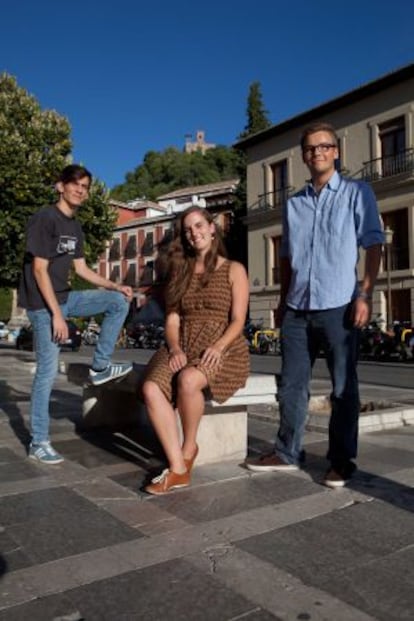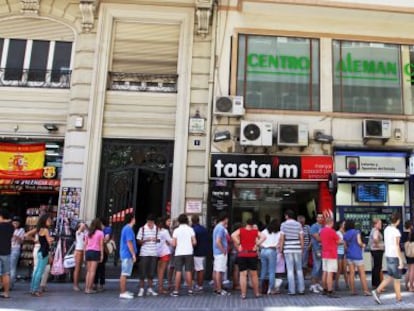Why Spain is top for Erasmus students
The weather and the social life draw thousands of foreigners every year The southern city of Granada is the preferred destination of most

Granada is one of Spain's most popular tourist destinations, attracting hundreds of thousands of visitors from around the world each year to the Alhambra UNESCO World Heritage Site. The city is also the destination of choice within the Erasmus program, which offers European university students the chance to spend a year of their degree course within another EU center of higher learning. Each year, around 2,000 students head to the Andalusian city - drawn, it must be said, as much by Granada's lively nightlife as they are by its educational excellence. Granada is the most popular city in the most popular country for Erasmus students, with more than 37,000 spending a term in Spain.
Among them is Insa Wiese, a 21-year-old politics student. She says she wants to focus on immigration issues, and that Granada seemed like the ideal place. Robin Weiss, another German student in Granada, finally opted for Spain over the United Kingdom. "I wanted a real change of culture," he says. It's not clear whether Granada, and Spain, will be receiving many more Erasmus students in the coming years. EU cutbacks mean that the program's 90-million-euro budget is about to be drastically reduced.
Insa and Robin believe that Erasmus contributes to a "strengthening of the European identity," particularly the chance to learn a foreign language.
Granada is seen as a place where the cost of living is relatively low
Karin Ufert, a Lithuanian member of the European Association of Students and a researcher at the Alex Katsomitros Education without Borders Observatory, and Dennis Abbot, the European Commission's Education spokesman, say that beyond Spain's reputation for sunshine and late-night carousing, students are attracted by the chance to learn a language that is also spoken throughout Latin America, and which is increasingly important as a lingua franca in the United States.
Robin Weiss says that he has had some difficulties keeping up with the Spanish spoken by his lecturers, whom, he says, speak "very quickly."
Dorothy Kelly, the Vice Rector for International Relations at Granada University, says that when so many different cultures come together in the classroom, as happens at Granada, with its large annual influx of foreign students, "small problems at the academic level are to be expected." But she says that in the long run, experience shows that students and teachers benefit, and that one of the results is a more flexible approach to teaching. "Each country has different teaching methods, and it's impossible to say which is best, but the important thing we notice here is that the relationship between teachers and students changes," she says.
Most students opt to live in the old part of the city, despite the long bus ride
The internationalization of Granada University has "radically transformed" its five campuses, scattered throughout the city, as well as its classrooms. "These have become multilingual, multinational, and multicultural facilities, fertile soil for the exchange of ideas, including those that cannot be taken to other countries," says Kelly.
For short-stay courses like Erasmus, academic criteria are rarely the deal breaker for students when choosing a foreign university, says Ulrich Teichler, a researcher at the University of Kassel, in Germany. That said, universities must meet certain academic levels. "I think that many Spanish universities enjoy a high degree of international prestige," he says. Dennis Abbot of the European Commission adds that the academic standards in many Spanish universities are of "a very high quality."
The program
- Top of the class. Spain receives the most Erasmus students: 37,432 during the 2010-2011 academic year.
- Andalusia and Granada. Within Spain, Andalusia is the top destination for Erasmus students. The University of Granada heads the European ranking of campuses with most Erasmus students (2,019). It's followed by Valencia (1,693) and Madrid's Complutense (1,678).
- The budget. The European Commission spends 450 million euros a year in the 27 member states on the program. The host countries also provide funds, as do many regional governments in the case of Spain. The Education Ministry in Spain has cut spending on the program over two years from 62.7 million to 15.2 million.
- Grants. On a monthly basis, an Erasmus student from Granada will get 110 euros from the EU, up to 120 euros from the Education Ministry and between 38 and 298 euros from the region, depending on other grants.
Spain has benefitted from being such a popular destination for EU students, as Juan Colino of the Erasmus Student Network points out. "Agreements are normally bilateral, between faculties, so that if a student comes here from a particular university, the university here will send a student back. And of course, Granada is the university with the most students at other European universities."
Among the factors that make Spain the top choice for Erasmus students are the weather, its social life, and the widespread belief that Spaniards are open and friendly. It is also seen as a place where the cost of living is relatively low. That said, Insa and Robin both say that their grant is not enough to live on and that their parents have helped them out.
Granada is probably among the cheaper cities in Spain in which to live. The city has certainly benefitted from its student population, and bars make a good living. The rental market has also enjoyed a boom in recent years, with some 65,000 students requiring accommodation each year. Erasmus students have a good reputation for looking after properties and paying their rent on time. Robin and Insa had few problems finding somewhere to stay when they arrived in the city. Like most other students, they opted to live in the old part, although this means a lengthy bus ride in the morning to the university campuses. The three say that among the biggest culture clashes is the Spanish sense of time. "Everything seems to happen a couple of hours later than when agreed," says Robin. They all say that they would like to return to Spain, and would like to work in the EU.
In the meantime, they intend to make the most of their stay in Spain, and to travel as much as possible. They first intend to get to know Andalusia, with Marbella and Ronda at the top of their lists. They also hope to rely less and less on their translator in class. Insa says that although she enjoys the social life, she takes her studies seriously, often staying behind late. "Mind you, a little voice whispers in my ear that I should get out more often," she confides.
Tu suscripción se está usando en otro dispositivo
¿Quieres añadir otro usuario a tu suscripción?
Si continúas leyendo en este dispositivo, no se podrá leer en el otro.
FlechaTu suscripción se está usando en otro dispositivo y solo puedes acceder a EL PAÍS desde un dispositivo a la vez.
Si quieres compartir tu cuenta, cambia tu suscripción a la modalidad Premium, así podrás añadir otro usuario. Cada uno accederá con su propia cuenta de email, lo que os permitirá personalizar vuestra experiencia en EL PAÍS.
¿Tienes una suscripción de empresa? Accede aquí para contratar más cuentas.
En el caso de no saber quién está usando tu cuenta, te recomendamos cambiar tu contraseña aquí.
Si decides continuar compartiendo tu cuenta, este mensaje se mostrará en tu dispositivo y en el de la otra persona que está usando tu cuenta de forma indefinida, afectando a tu experiencia de lectura. Puedes consultar aquí los términos y condiciones de la suscripción digital.
More information
Últimas noticias
Maduro pleads not guilty before the federal court in New York: ‘I am still the president of Venezuela’
A new test can detect Alzheimer’s from a finger prick
UN team enters Sudanese city of El Fasher after paramilitary massacre: ‘It’s like a ghost town’
A recipe for resistance: Indigenous peoples politicize their struggles from the kitchen
Most viewed
- Gilles Lipovetsky: ‘If you want to live better and fall in love, take Prozac, don’t look to philosophy’
- Alain Aspect, Nobel laureate in physics: ‘Einstein was so smart that he would have had to recognize quantum entanglement’
- Alvin Hellerstein, a 92-year-old judge appointed by Bill Clinton, to preside over Maduro’s trial in New York
- Maduro’s downfall puts China’s relationship with Venezuela to the test
- Why oil has been at the center of Venezuela-US conflicts for decades









































